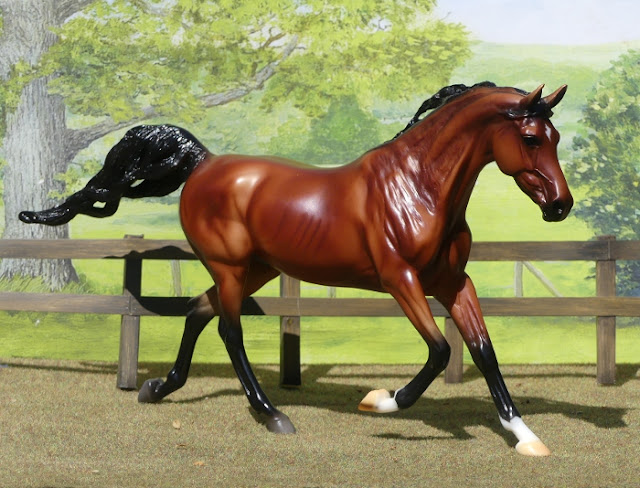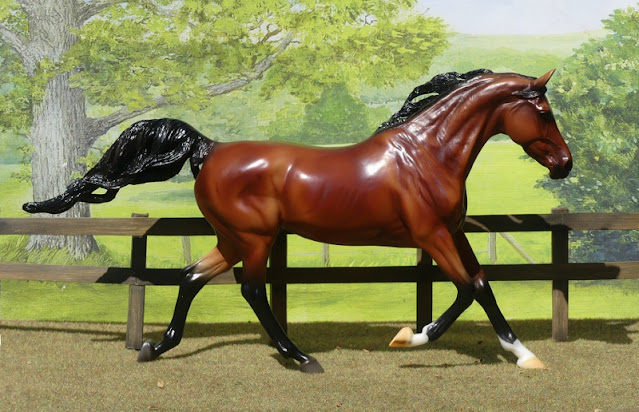Something very different for a change! Papo's magnificent Megaloceros sculpt becomes my first ever prehistoric repaint, the first deer model to enter my collection, and my first custom to come with his own illustration!
When I paint my horses, I'm generally working from a reference photo or two for the colour or pattern I'm trying to recreate, or just making up something I know is realistic, from memory - because, well, I've seen horses before!
With my other wildlife repaints - the Fox, the Cormorant, and the Hare - I've used nice big clear photos from Google to make sure I'm getting the markings and colours in as realistically as possible, in terms of placement, detailing, and paint mixing.
I've painted an extinct animal before - the Quagga - but the Megaloceros (also known as Irish Elk) went extinct a little less than 8000 years ago, rather than lasting into the modern era and leaving photographs and taxidermy specimens in museums.
All the same, I knew I'd be much happier and more confident working from some kind of reference, rather than trying to design my paintwork actually on the model with wet paint and trial-and-error layers to make design changes as I went along.
And I really didn't want to piggyback off someone else's efforts, recreating somebody else's reconstruction or illustrative art from books or CGI tv episodes; even though that can be an honest tribute and perfectly valid resource, I want this to be my interpretation, not borrowing someone else's creativity.
Luckily, we do have one fantastic source for information on how prehistoric wildlife looked, in cave art which has survived all down the centuries from the people who saw the animals first hand.
Here's the first example. All we can really gain from this one is a general impression of darker on the neck and shoulder, and along the back - but it's possible the painting is either unfinished, or cropped to focus on the head and antlers, and the 'paler' part is just not there!
Here is the next example, a much more complete animal. Again, we see darker along the back, the neck and throat, and the shoulder added as shading within the outline. There's also a very distinct diagonal stripe from the hump at the shoulders down to where the hind leg meets the underside of the belly. This is a recurring detail in cave paintings from different locations, so can't just be one artist's weird quirk or error in constructing the body shape - more than one person painted a stripe, it's reasonable to take that as proof it was there.
Here is another example, two animals overlapping but if you just follow one set of lines at a time, you see the same thing - dark hump, dark shoulder (as a stripe this time), diagonal body stripe . There's also a dark throat, though this time the neck itself is paler.
Of course, all these paintings are simplified, and stylised, and all are more outlines with markings, rather than full colour like some of the horse and cattle paintings, where we can see shades of brown entirely filling in the body shapes.
But the general idea I get from them, and other examples, is a paler body colour with a darker top line, dark neck possibly with throat and chest 'collars' rather than a single wide band, and there must be a marking along the side.
When I was reading up on the Megaloceros, I learnt they were a relative of the Fallow Deer rather than the Red Deer, which makes perfect sense when you consider the antler shape in all the preserved remains.
This is my only real-life connection to the species, by the way - I have seen a head of 'Irish Elk' antlers on the wall at a castle here in the UK, found in a bog and mounted as an impressive curiosity in the 19th century gentleman-naturalist boom era.
So I decided it was quite important to avoid making the model look like an oversized (and over-antlered!) Red Deer when designing my paintjob, and the best way to do this would be to not even look at Reds in my preparation time, and take my colour palette from a darkish Fallow stag - this exact photo, to be precise.
The markings I've adapted, of course, by adding in the diagonal band along the side of the body, and altering the placing of the white and dark from the throat down toward the chest. I just worked where it seems to naturally blend and mix with the real deer's colour, while keeping each marking we see in the cave art.
And I've taken the spots away entirely - because I'm sure if the ancient deer had had such a noticeable feature, the cave artists would've put them in. They painted some spotted horses, and DNA analysis on horse bones and teeth from the era has proven leopard spotting genes were present in the prehistoric horse population at that time. Other animals in the same caves, like Red Deer and Przewalski-looking dun horses, are painted in accurate colours we easily recognise today. So I think the painters can be trusted on this, and if there were spots, they'd have put spots.
Enough rambling, here's the actual picture bit of the post (well done if you read all that instead of just scrolling this far, hahah). I've never drawn a deer before, so I worked from the Papo model instead of figuring out anatomy and inventing a different pose from scratch, and after all, it's for him rather than a stand-alone artwork in it's own right.
Here he is blank and waiting for his colour.
My intended design - though I'm not sure how easy it will be to match the actual paintwork to what I've done with him here! But I don't mind if it's a little different, and I'm not going to drive myself crazy trying to replicate these precise shades and blending exactly, as after all it's all guesswork and based on tweaking a modern animal, cos none of us have seen the real thing, except those cave artists who left us such helpful clues!
And finally, here he is with a background, just cos he makes a pretty portrait (recycled from the folder of my older art - that one originally had a horse in front of most of it so it's a bit rough and unfinished, but was the only background I had which didn't include a hedge, gate, stone wall, brick-walled stable yard, or ploughed field!)
Now, on to the model...
Here's the before picture, so you can see what colour he started out.
He's not the same scale as Papo's horse models, or any of the other horse ranges you'd be familiar with, so I can't really say 'oh, he's a big as a so-and-so' to give you a better mental image - I'd say he's standing around halfway between Breyer Stablemates and Schleich/CollectA large breeds in size, but not scale - remember, the Megaloceros was much bigger than a horse in real life, more like a moose (although not many of us in the UK have ever seen a moose either!)
And now some in-progress stages. Apologies they're not very bright or clear photos, I started too late in the day to use real sunlight, and I couldn't figure out how to switch on the flash on my camera!
Layer one, adding some more milk-chocolate brown to soften down the dark colour, and some tan shading where the lighter parts start.
Starting the texturing of the body colour, and beginning the detailing of the face, with light round the eyes and nose. At this stage, I'm using some dry-brushing to catch the sculpted texture on the mould, and at other times I lick the brush then touch it to the paint, so it's diluted and thinner. As I've said before, only do this if you're sure your paint isn't poisonous; if you're not certain it's safe and/or you're less lazy than me, you could set up a soaked sponge in a bowl to get the same damped effect, without saturating your brush too much like dipping in a glass of water would.
And now upping the contrast a bit, with added white for the chest & belly, and darker colour for the back of the neck, shoulder hump, and side/chest stripe markings. Again, there's some dry-brushing and some fine brushstrokes.
I tried to make the markings quite blended in and not have a 'painted on afterwards' look, I know some animals do have very sharply defined stripes (like the dark band markings on Thompson's gazelles) but cos the sculpt has quite shaggy fur I didn't think there could be quite such a crisp dividing line between black and beige, more of a soft overlap would happen.
More definition and detail for the markings, especially filling in the face with eyes and nose and a hint of pink inside the ears, then the feet (I always do them toward the end, otherwise handling the model on my lap to continue the body colour rubs the paint off the edges and toe-tips), and finally the antlers. They were done with a base layer of beige, then blacks and browns dabbed on with a very fat brush, to try to get a different texture to the body fur. The very tips are given white highlights - where deer rub their antlers the bone polishes very clean, white and smooth at the points.
Finished!
The next day, he went outside for a much better photoshoot in the sunshine...
I'm so pleased with how he turned out, I really like him and will enjoy having him in my collection, even if he is my only prehistoric mammal and has no friends to stand with yet.
The shade makes his dark markings stand out more, but he looks prettier in the sun, so most of the other photos I've chosen do favour bright light.
I may have gone a bit overboard on the number of pics, but this sculpt looks great from so many angles!
Those antlers are just amazing; they'd look impossibly impractical and unrealistic, if we didn't have so many examples as proof in real life, from peat bogs and the like!
You know that feeling when a Red deer stag stares you down, and you don't know whether to feel intimidated cos he's massive and potentially dangerous, or safe cos you're such a small insignificant creature in comparison that he'd not even waste the energy to come at you? This one has the same look about him!
SUCH a handsome head! I'm really pleased with his face, but the sculpt has a lot of detail there anyway, so it's giving me a lot to work with. I took his face markings from another Fallow deer reference; the little pale rings around the eye which help exaggerate it, and the way the profile of the nose shades to dark, but with white just around the nose and mouth.
I took a couple of different headshots without the miniature background, his outline contrasting nicely against my nice dark hedge.
A close-up portrait, and more of that mildly-threatening side-eye going on!
I'm considering doing a cave-painting inspired prehistoric horse next, so he's got some contemporary company, though there's no specific sculpt for that era so I'd be picking from modern horse breeds to find the most primitive look. Perhaps the CollectA Mongolian for that upright mane and flat back, or the Exmoor or Konik which are so often described as the closest to our European horses' ancestors.
For now, I'm just happy with my little giant deer!




























